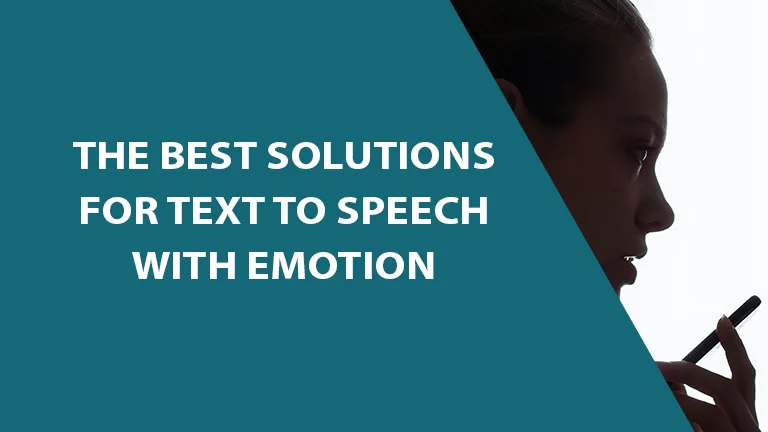The Best Solutions For Text to Speech with Emotion
Explore the transformative world of Text to Speech with Emotion, where AI voices bring written words to life. Discover how this technology enhances e-learning, marketing, and customer service by turning text into emotionally charged speech. Learn how to create, utilize, and benefit from TTS models, and delve into practical applications across multiple languages.

Transforming Voice Tech with Emotional Insight
The transformative wave of voice technology with emotional insight is reshaping how we interact with digital content. By integrating emotion into text-to-speech (TTS) systems, this innovation offers a more natural and engaging user experience. It bridges the gap between human emotions and machine output, allowing AI to convey a range of feelings—from happiness to sadness—making digital interactions more human-like and relatable. This leap forward in voice technology enhances various applications, from virtual assistants to customer service, revolutionizing the way we communicate with technology.

| Goal 🎯 | Best TTS approach 🧠 | Emotional features to focus on 💓 | Tech notes 🔍 | Where Scrile helps 🧩 |
|---|---|---|---|---|
| Quick voiceovers & social clips | Online TTS tools with emotion presets | Ready-made emotions (happy, calm, sad), pitch & speed controls, SSML tags | Runs in the cloud, browser UI, no coding needed | Use Scrile Connect AI Creators to generate short emotional voiceovers for Reels, shorts, ads, and promos |
| Long-form content (podcasts, audiobooks, YouTube) | Neural TTS with voice cloning | Stable tone over hours, natural breathing, expressive storytelling | Neural / transformer TTS, support for chapters, markup for emphasis | Build a recurring AI voice persona in Scrile AI or Scrile Connect AI Creators and reuse it across episodes |
| Accessibility & assistive reading | Clear, neutral, emotion-aware TTS voices | Gentle, supportive tone, high intelligibility, multi-language support | Low latency, mobile-friendly, sometimes offline operation | Pair emotional TTS with Scrile AI as a companion “guide” that narrates content and reacts to user context |
| Customer support & IVR systems | Contact-center TTS with sentiment-aware responses | Calm, empathetic reactions to complaints; upbeat tone for good news | Integrates with chatbots, CRMs, call routing and analytics | Design branded support personas in Scrile AI that speak via TTS and adapt tone to customer mood |
| E-learning & training platforms | Educational TTS with adjustable pace and emphasis | Encouraging tone, clear stress on key terms, different voices for roles | Works inside LMS, supports slides, quizzes and multi-language courses | Use Scrile Connect AI Creators to voice lessons, micro-courses and explainer videos with emotional variety |
| Marketing videos & promo campaigns | High-impact commercial TTS with rich prosody | Excited launch tone, warm storytelling, persuasive calls-to-action | Exports as high-quality audio for editors (MP4, WAV, etc.) | Combine emotional TTS with Scrile’s video tools to create branded ads, product explainers and sales videos |
| Language learning & pronunciation drills | Multi-language neural TTS with phoneme control | Clear articulation, natural intonation patterns, contrasting emotional tones | Uses IPA/phoneme-level control, supports examples and repetitions | Power interactive language bots in Scrile AI that speak with emotions and help learners mimic real speech |
| Indie apps, games & experiments | API-based TTS integrated into your own product | Character-specific emotions (hero, villain, narrator), dynamic reactions | Requires API integration, event-based playback inside app or game | Use Scrile AI as the “brain” that decides what the character says and which emotional TTS variant to trigger |
| Monetizing AI voices & TTS models | Platform-style setup for selling packs, voices, or access | Consistent branded sound, license-safe voices, emotional presets as “products” | Needs user accounts, payments, content delivery & analytics | Launch your own AI voice / TTS marketplace on Scrile (Connect/AI) and sell access to emotional voices safely |
Decoding Emotionally Enhanced Text-to-Speech models
Decoding Emotionally Enhanced Text-to-Speech involves understanding how artificial intelligence can be used to embed real-life emotions into digital speech. This advancement allows TTS systems to not only articulate words but also convey feelings, mirroring human expressions and enhancing the listener’s engagement. By analyzing voice tones, speed, and inflections, AI can reproduce emotional states, transforming the monotonous, robotic voices of the past into rich, dynamic, and human-like audio experiences.
In this advanced realm, the transformation of text input into emotional audio output is achieved through sophisticated AI voice synthesis. This technology ensures that the created audio files are not just articulate but emotionally resonant, employing realistic AI voices that can speak in multiple languages. This nuanced approach enables a broad spectrum of emotional expression, turning standard digital communications into more impactful, human-like experiences. The result is a more engaging and relatable audio file, significantly enhancing the listener’s connection to the content.
Practical Illustrations and Ideas
Practical illustrations and ideas for emotionally enhanced text-to-speech can range from creating engaging e-learning modules that maintain student interest to producing dynamic, emotionally resonant marketing videos. For instance, a digital health app might use comforting tones to provide mental health support, while an online retailer could employ enthusiastic voices to highlight special offers, making interactions more engaging and effective.
Further, emotionally enhanced TTS can revolutionize customer service by synthesizing speech that adapts to customer emotions, turning text inputs from inquiries or complaints into comforting or understanding responses. Additionally, educational platforms can leverage this technology to synthesize speech in multiple languages, making learning accessible and personalized. Note, when crafting content, the key is to convert written words into spoken language that reflects the intended tone, thus broadening the impact across diverse audiences.

Prime 10 Applications for Emotionally Charged TTS model
Accessibility: Offering emotionally nuanced readings to aid those with visual impairments.
Podcasts: Injecting passion and dynamics into episodes through varied intonations.
Voice Cloning: Customizing experiences with emotionally tailored cloned voices.
IVR Systems: Humanizing automated customer service with natural-sounding voices.
Audiobooks: Enhancing storytelling by matching voice emotions with the narrative.
Marketing: Boosting brand connection through emotionally resonant messaging.
Video Voiceovers: Making video content more compelling with emotional depth.
E-Learning: Making educational content more engaging with varied emotional tones.
Social Media: Increasing engagement with lifelike, emotionally charged voiceovers.
Language Learning: Facilitating better understanding through emotion-infused pronunciation.
The prime applications for emotionally charged TTS include enhancing e-learning experiences, bringing life to audiobooks, elevating podcast dynamics, improving voiceovers for videos, refining IVR systems, increasing accessibility, enriching marketing content, boosting social media engagement, personalizing voice cloning, and aiding language learning with emotional intonation. These uses showcase the diverse and impactful ways emotionally infused TTS can enhance digital communication and content.

How to Create Emotional Human Voice cloning
Creating emotional TTS models involves integrating AI and machine learning to analyze and reproduce human-like emotions in speech. The process starts by training AI models with diverse datasets that include emotional speech patterns. Developers then refine these models to recognize and generate different emotions accurately. This approach enhances TTS systems, allowing them to deliver speech with authentic emotional undertones, thereby creating a more engaging and relatable user experience.
In advancing the creation of emotional TTS models, it’s essential to focus on natural language processing and sentiment analysis. By dissecting language’s emotional components, AI can better grasp context, allowing for nuanced voice generation. Furthermore, ongoing feedback and adjustments ensure these models adapt over time, improving their ability to convey a spectrum of emotions. This iterative process is crucial for developing TTS voices that are not only expressive but also resonate with users on an emotional level.
How Can You Convert Text to Voice with Emotion
To convert text to voice with emotion, start by selecting a TTS model that can produce natural-sounding speech and replicate human voice qualities. Input your text into the AI voice generator, choosing settings that best reflect the intended emotion, ensuring the output aligns with human speech patterns.
Next, refine the emotional tone to match your content’s context, adjusting the AI’s pitch, speed, and intonation to mirror natural human expressions. This step is crucial for creating an audio file that listeners can connect with on an emotional level.
Finally, review and tweak the generated speech to ensure it meets your requirements. Iterative adjustments can lead to a more polished and human-like result, making the digital voice more relatable and engaging for your audience.

How Do I Create a TTS AI Model in 5 Steps
Software Selection: Identify a TTS platform that supports advanced AI voice and emotional range. The choice of software significantly influences the ability to produce nuanced and natural speech.
Text Submission: Enter the script into the software. This text serves as the basis for the synthesized speech, converted by neural networks.
Emotion Choice: Select the appropriate emotion from the software’s options, leveraging the speech model’s capabilities to match the intended tone.
Voice Customization: Modify parameters such as pitch and speed. This step involves fine-tuning the speech model, often with input from voice actors, to ensure the voice sounds natural.
Speech Production: Generate speech using the platform, which employs neural networks to create lifelike audio. Review the synthesized speech, making adjustments as needed to achieve the desired outcome.
Finding and Using Emotion TTS
Finding and using Emotion TTS involves navigating to a voice generator that employs AI voice and deep learning models to ensure realistic and human-like outputs. This search is essential for those requiring advanced text-to-speech services that provide more than just monotone readings, but can actually reflect human emotions and intonations. By selecting a TTS method powered by sophisticated AI, users can leverage technology that generates speech closely mirroring human expressions.
Upon selecting the right tool, utilizing Emotion TTS becomes straightforward. Users input their text into the system, choose the desired emotional tone, and let the AI do the rest. These advanced systems employ deep learning to analyze text and context, thereby producing human-like voices filled with appropriate emotional nuances. This transformative approach allows for a wide range of applications, from educational content to customer service, enhancing both engagement and understanding.

Benefits and Examples of Natural Sounding Speech models
The benefits of text-to-speech speech models include transforming text into engaging, human-like audio, saving time and resources typically spent to hire voice actors. They enable more efficient and dynamic communication, particularly for businesses or educational settings.
Real-life examples of these models include voice assistants that provide conversational user experiences and educational platforms where AI voice enhances learning through audio clips. These applications show how AI can effectively convert written text to spoken word, improving accessibility and interaction.
Try Scrile AI Solution
Explore the Scrile Connect AI Creators service, designed for both individuals and teams aiming to elevate their content with AI. This platform enables the creation of AI-enhanced videos, voiceovers, and avatars, with multilingual support and various editing tools. It’s ideal for both personal and commercial projects, offering features like templates, real-time editing, and video marketing tools to streamline your creative process.
Our TTS solution includes:
Custom Solution: Tailored to meet specific content creation needs.
Integration: Compatible with various technologies for seamless workflow.
Quality Assurance and Support: Dedicated support ensures high-quality output and user satisfaction.
Explore these advantages and more with Scrile Connect AI Creators, the ultimate solution for enhancing your digital content creation.
Monetize Your AI Creations
If you’re exploring new revenue channels for your emotionally enhanced TTS models or any other AI-driven products—like AI art, video, or custom AI models—creating a dedicated platform can significantly expand your reach. By owning your site, you maintain full control over branding, user experience, and pricing strategies, ensuring you keep a larger share of the profits. This approach also makes it easier to build a loyal user base and stand out in a crowded market. Discover more about how to create your own site for selling AI creations and turn your innovative projects into a thriving business.
Frequently Asked Questions
What is ‘Free Emotional Text to Speech’?
‘Free Emotional Text to Speech’ denotes a type of TTS service allowing users to create audio outputs with various emotional nuances at no extra charge. This technology enables more expressive and engaging digital communication without the financial burden of traditional methods.
How to Create Voiceovers with Emotion?
To create voiceovers with emotion, users can utilize platforms like Scrile AI to choose from a range of emotional tones. These tones can then be integrated into the AI-generated voice, providing a more dynamic and engaging listening experience.
Is there a free AI to generate text to voice?
Yes, there are various free AI tools available that can generate text-to-voice outputs. While they offer a range of features, including emotional expressiveness, the extent and quality of these features can differ among apps.
How do you add emotions to text-to-speech?
To add emotions to text-to-speech, incorporate emotional language into your script, choosing words with strong emotional connotations. This method enhances the emotional impact of the AI-generated speech, making the content more relatable and impactful for listeners.
How do I make my AI voice more emotional?
To make your AI voice more emotional, you can tweak the settings in your text-to-speech software to adjust tone, pitch, and speed. Additionally, using emotionally charged words and phrases in your text can help the AI better interpret and convey the intended feelings. Experiment with different settings and text to find the combination that best expresses the desired emotions.
Read Also
| Link | Why to read |
|---|---|
| AI Talking App | See how emotional TTS slots into a full talking app architecture. |
| AI Text App | Pair TTS with high-quality text generation for lifelike dialogue. |
| Robot Assistant | Use emotive speech in embodied/agent assistants to guide user actions. |
| AI for Webcam Sites | Leverage expressive voice to increase tips, session time, and conversions. |
